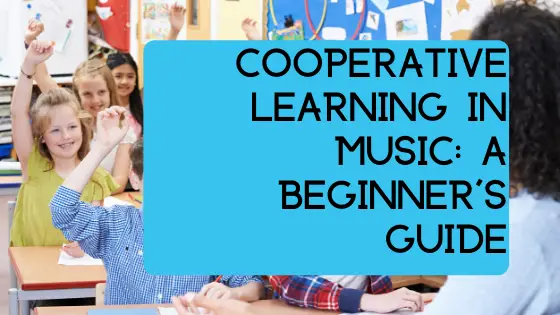I’ve attended many training sessions in my years of teaching music, and one that keeps popping up is cooperative learning.
Like some of you, I wrote it off initially as a fad, but when I dug deeper, I realized how powerful this style of teaching is and how much music teachers already use these techniques without even realizing it.
I decided to do some research as part of my Master’s degree on these strategies and implement them in my own classroom.
Wow! What a difference!
But it surprised me there weren’t a lot of simple starter guides out there for music teachers which is where this article comes in.
Here is the Cooperative Learning In Music beginner’s guide.
Note: I approach this from an elementary music teacher’s perspective, but secondary music classes will benefit from this as well with minimal adaptations.
Much of the article is pulled from my literature review on the subject.
Click the button if you want to download the wordy, academic version of this post. (This is also where you’ll find the sources.)
Table of Contents
What Is Cooperative Learning?
Cooperative learning (CL) isn’t owned by any one person or company. It’s a strategy for engaging students more in their own learning.
CL is defined as the teacher setting up small-group structures and goals for students to work together to build a better product or learning experience.
The teacher must play an active role in the functioning of these groups and give students the tools to work together successfully.
In other words, the students are combining their skills and knowledge to teach each other and build a better answer.
Hallmarks of CL include student-driven instruction, social learning, and teacher facilitation rather than direct instruction.
Despite what some teachers believe, CL isn’t just for math or reading. The strategies apply to any content area and actually align themselves quite naturally with music.
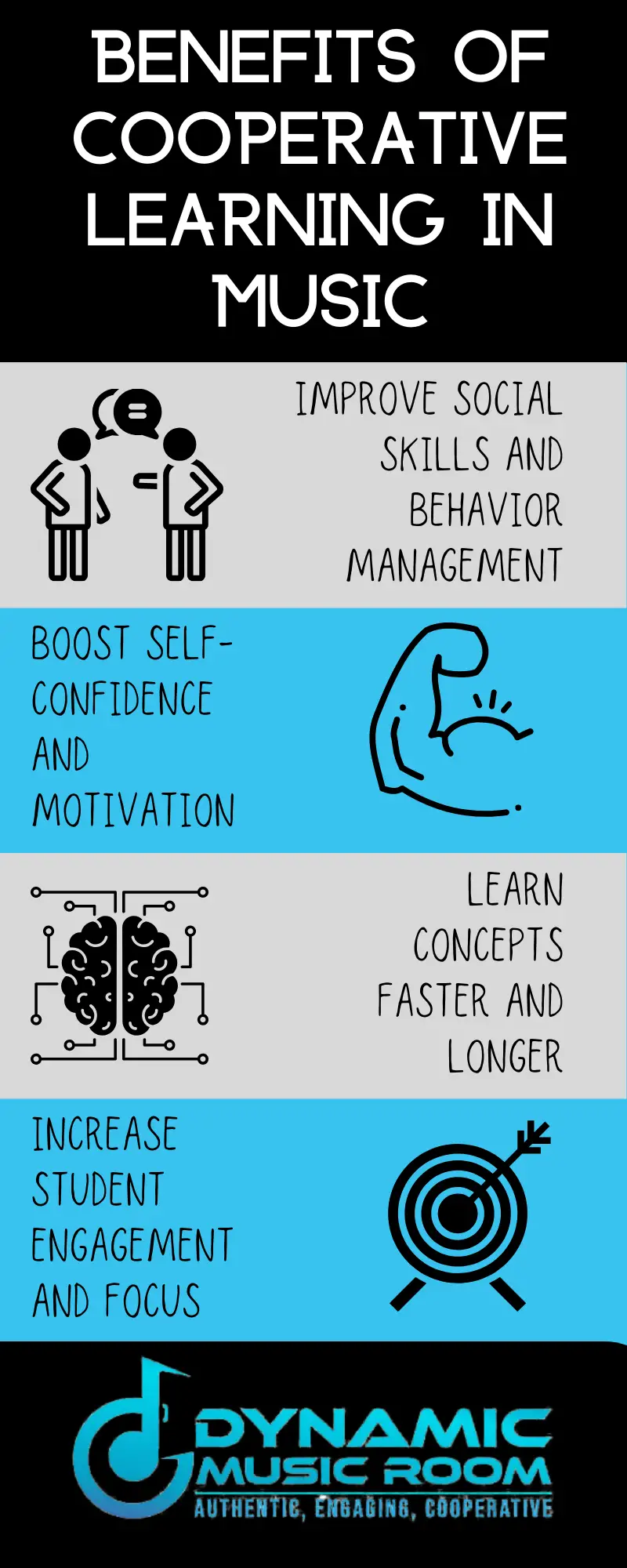
What Are The Benefits Of Cooperative Learning In Music?
Whether you think cooperative learning in music classrooms is a good idea or not, you’re right to question any new method’s effectiveness. Let’s look at the benefits, and then decide for yourself.
Social And Behavior Benefits
The first big benefits with CL are the increased positive social interaction and behaviors.
As part of the CL process, students are specifically taught how to work together positively in a structure designed to give each student a role.
The teacher’s job of circulating and providing feedback and redirection actually improves desirable behavior and reduces the negative ones.
To many, student groups seem chaotic, but when done well, most or all students are on-task and engaged.
Even in elementary grades as young as Kindergarten, using cooperative learning techniques correctly showed a substantial (56-80%) decrease in off-task behavior.
Teachers have said they feel they’re students enjoy this style of learning more, and this is backed with data collected from students across different grade levels and subject areas.
Boost Confidence And Self-Motivation
There are numerous studies out there which show students are more motivated intrinsically to work when others of their peer group are counting on them.
The act of teaching each other and taking turns being leaders in small groups also raises self-confidence.
These are all parts of cooperative learning, and research has shown a clear positive trend in all areas at all grade levels including adults.
Learn Concepts Faster For Longer
Another key benefit stemming from cooperative learning techniques is a quicker and longer lasting understanding of the concepts.
There is some speculation as to why this is.
Is it because students have to reexplain and define their own thinking? Possibly.
Is it because students are more engaged and confident? Probably.
I think a key part of the learning increase is due to learning styles.
We’re all familiar with Gardner’s theory of multiple intelligences (if you’re not, learn more at Edutopia).
Two of the most often forgotten learning styles revolve around social intelligences. We ignore these at our own peril.
Implementing CL learning strategies correctly and consistently provides a way to reach these intelligences on top of and combined with the more common ones.
Increased Engagement
We’ve touched on this before, but CL has a much higher instance of on-task behavior and equal engagement.
As part of cooperative learning (which we’ll dig into a little more in the next section), students are split into groups, but many teachers who attempt group work will complain about stronger and more capable students taking over while others take a back seat.
This is true if you only do small groups and leave it at this.
CL requires structure and specific jobs assigned to students to ensure more equal participation. With this, all students will be more engaged as they each have a job which makes them essential to the group.
On top of this, the majority of students find it more fun to be a part of a group with their classmates anyway.
More engagement = more learning = less off-task behavior
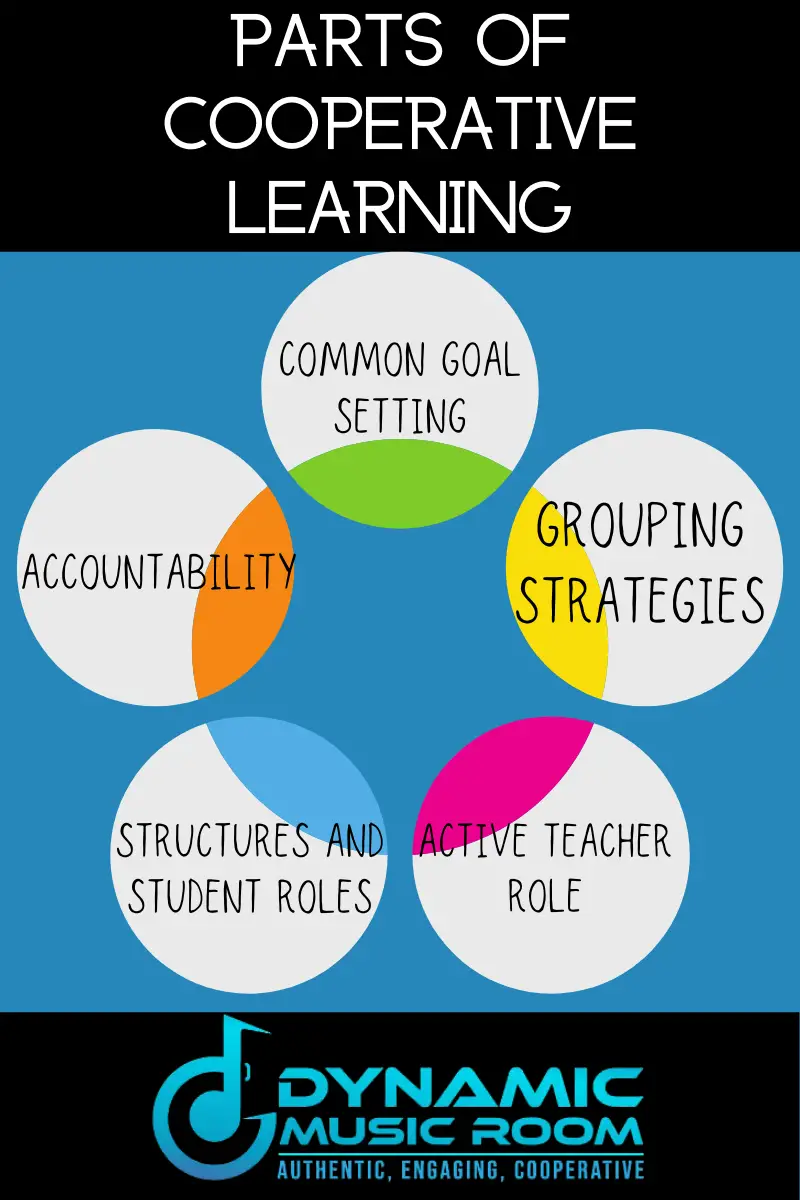
What Makes Up Cooperative Learning?
In this section, we’ll go over the 5 main parts of cooperative learning. These parts are drawn from research on the top 3 CL experts, Kagan, Cangro, and Slavin.
While there are differences in the terminology and priorities of each element, all are considered a must in order to do true CL.
Common Goal Setting
It’s not enough to just get students in groups, the groups must be unified in a common goal. This gives the students’ an end-goal to work towards and keep them on track.
The goals may be flexible depending on the task required, and students may help to create and define the goals for their group.
But the goal must be present.
For younger students and at the beginning of cooperative learning, it’s better if the teacher sets a goal with clearly defined parameters and expectations.
Grouping Strategies
Grouping strategies are one of the most easily recognized elements of CL.
There is a lot going into the picking of groups, and there are some common beliefs which define these grouping strategies.
Some research debunks the effectiveness of the strategies over one another, but all these methods work well.
It’s best to mix it up rather than just keep kids in the same groups all the time.
Here are some selection strategies you may wish to use at some point:
- Random (the quickest method)
- Teacher chosen (most intentional and affective, but requires extra work on your part)
- Student-selected (students are usually happier and more engaged, but it may result in more off-task behavior)
When the teacher selects the groups, most experts suggest the following ideas in the picking:
- Equal number of boys and girls
- One high achieving student, one low achieving student, and the rest from the middle
- Diverse socio-economic and racial backgrounds if possible
Take care to make the groups seem random, or the “low” students will know they’re being labeled as such.
Group Sizes
For group sizes, consider the following rule:
The more complicated the task, the larger the group. The shorter and simpler task is smaller. No less than 2 and no more than 6. Groups with 4 students are ideal in most cases.
In music classes, especially elementary music, we don’t always have time to plan out the groups for the 100s of students we see, so it’s OK to do what I call a “selectively random” grouping.
Put groups together randomly while intentionally separating those who don’t work well together and making sure you don’t get a group of all “high” or all “low”.
Accountability
Most teachers when using group work in the classroom will naturally do the first two elements, but it’s here they fall off.
Without these last 3 ideas, the group work will always fail to reach its full potential.
In fact, some research shows group work without these last 3 will actually harm some students’ learning potential.
The first is accountability.
You must have some way to check on the work.
Sounds simple and easy, but the accountability needs to come in 2 parts:
- Accountability as a whole group
- Accountability on an individual level
Your “check-in” or product needs to check both of these levels. CL is extra effective if every student is responsible for their group, themselves, and the others in their group.
In this way, every student must do their part.
A simple example of this in music class is as follows:
Task: Create and perform a 16 beat rhythm in a 4 person group.
Group Accountability: The group must perform and show the teacher or class their rhythm.
Individual Accountability: Each student must create 4 beats of the rhythm on their own and contribute to the whole.
In this way, the students work together to create a whole product for their group accountability, but they’re also responsible for their own work.
If one student fails to do their part, it harms the whole group.
Teacher Role
A lot of teachers who don’t see correctly-used CL view it as “lazy.”
In their eyes, the teacher gives the lesson and sits back while students do all the work.
This is, sadly, what some teachers do, but it’s not effective or what is intended with true cooperative learning.
Teachers play an active role in the entire process; it’s just different from the traditional style of teaching.
First, teachers need to plan and prepare the materials, groups, and delivery of expectations.
Then, teachers need to set up clear expectations and model appropriate social interaction.
This is where most teachers fail. Without giving the students the language and example they need, the students resort to what they know.
The default for student-student interaction is how they play at recess or interact when they hang out outside of school.
They don’t naturally know how to work together constructively (many adults don’t either). It’s a learned skill, and the teacher needs to model and teach this.
Once students are split into groups, the teacher has two jobs to cover at the same time. Neither of them are sitting back and taking a nap.
Teachers need to facilitate deeper learning. This is done by checking the groups’ work and asking probing questions or constructive feedback.
The teacher also needs to monitor and redirect behavior. It’s inevitable that some students will get off-task.
But by following through with expectations right away and redirecting, the students will fall into a default of more on-task behavior.
Not lazy at all, right?
Structures
Cooperative learning structures is another one of the most important elements which set CL apart from plain old group learning.
Some methods have specific names, language, and setup used for their structures. In fact, Kagan Cooperative Learning is built almost entirely around pre-made structures.
Kagan structures aren’t the only way to go, but each structure is built in such a way it hits the most important structure points.
Structures center around the types of activities used to reinforce learning, provide student roles to ensure better group and individual accountability as well as offer structured ways to interact socially.
Basically, a plan or structure will hit all the points from above in a clearly defined way.
It’s OK to invent or adapt your own structures as long as everything else is covered above.
(Or you may want to check out some resources listed later in the guide and save yourself some time.)
Can This Be Applied To Music?
Maybe all of this sounds great to you, but you wonder:
Does this work with music too?
Yes! Emphatically, yes!
Sure, CL was born out of reading and math, but the strategies exist outside of these and benefit literally any subject area at any grade level from Kindergarten to adulthood!
The knowledge and activities look different for us and different for each grade level, but there are easy ways to adapt and integrate them to our content.
Don’t give up because you don’t see how to apply it right away.
The next 2 sections offer 3 practical examples I use with my elementary students and steps to create your own plan, and the resource section shares some music-specific CL references as well.
Simple Steps To Build A Cooperative Learning In Music Lesson
These are the steps I go through to build a CL lesson plan for music. This is usable for all grades and types of music classes.
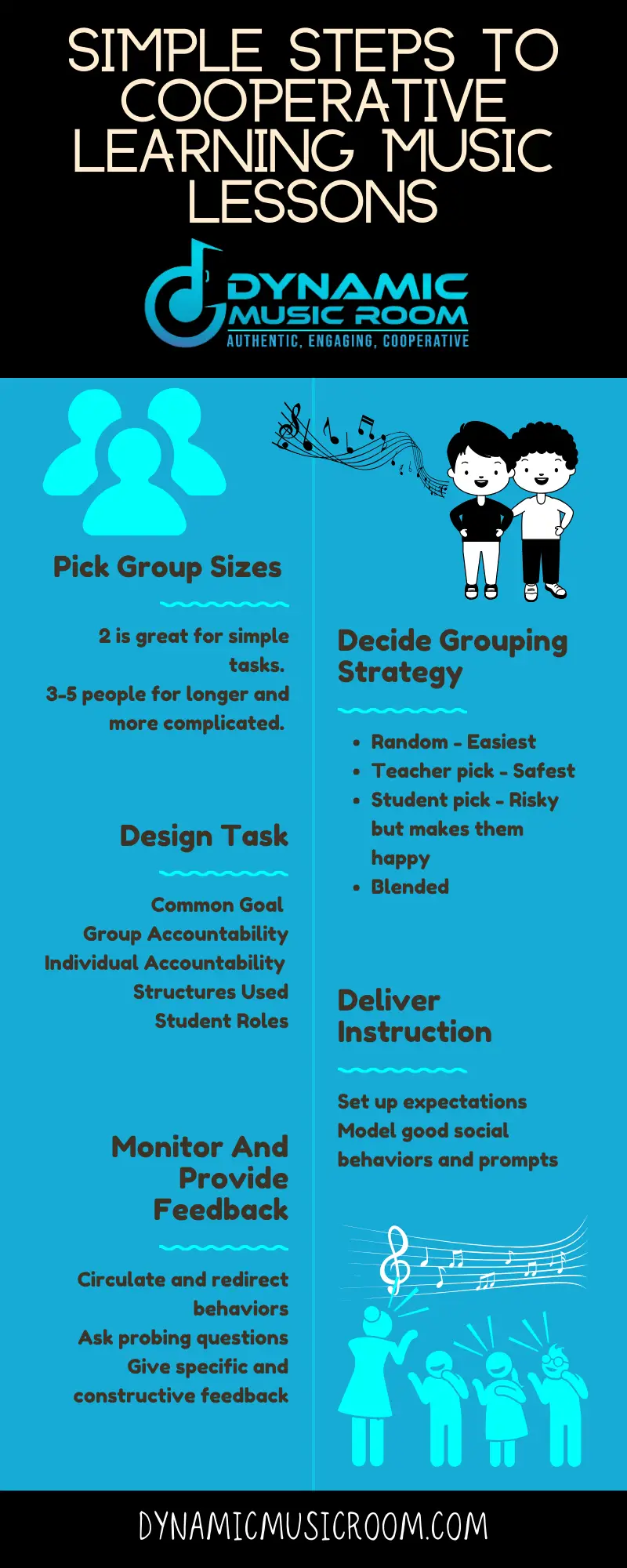
3 Concrete Cooperative Learning In Music Activities
Here are 3 examples of CL lessons I have actually used in my classroom with success. These are adaptable to any grade level, but I’ll offer the examples using a specific concept and grade to help give you an idea.
Match My Rhythm
Grade: Second Grade
Musical Concept: Rhythms – half notes, paired eighth notes, quarter rests, quarter notes
Grouping: 2-3, teacher selected
Goal: 1 student (coach) will be able to describe rhythm using syllables while the other 1-2 students (listeners) will write down the rhythms they hear.
Accountability:
- Group: The group must get at least 5 successful matchings. The correctly matched ones must be set aside.
- Individual: Each student must have at least one match as a leader. The 1+ they match as the coach must be set aside for the teacher to check.
Materials: White board and markers for students to write on as listeners, rhythm note cards for coaches to use and describe.
Expectations:
- Only the coach is allowed to talk
- The coach may only say their rhythm 3 times
- Listeners may signal they’ve got it with a thumbs up when they’re ready
- All activity stops when they hear the teacher’s attention signal
- If a student has not gotten a match as the coach, this student gets turns until they have it correct
- If the group has a question, they all raise their hands and wait until the teacher comes to them
Social Prompts:
When the listeners get it right:
Wow listeners! You heard my rhythm correctly. Nice focus!
When the listeners get it wrong:
Hmm…your rhythm doesn’t quite match mine. See it here (show the card). This should be like this (say the rhythm). You’ll get it next time, good focus!
When the coach says it wrong:
I like your confidence, but I think it’s supposed to go like this (say the rhythm). Let’s try another one. You’ve got this!
If there is any disagreement, the teacher may be called on to settle the dispute.
Procedure Explanation:
The group of 2-3 people have 1 coach and 2 listeners. Every student has a white board, marker, and eraser.
The coach draws a rhythm card, so the others can’t see.
The coach says the rhythm 3 times with a pause in between each time.
Listeners write down the rhythm as best they can. If they think they have it, they give a thumbs up.
When all listeners have a thumbs up or the rhythm has been said 3 times, the coach shows the card to the group.
The coach (only) checks the work and gives the prompt from above based on if they’re right or wrong.
If all listeners have it right, this card is set off to the side.
The next listeners on the left becomes the new coach and the process is repeated.
Repeat until 5 rhythm cards are set off to the side as correct and each student has been a successful coach.
Lightning Pair And Share
Grade: Kindergarten
Musical Concept: Singing with a steady beat
Grouping: 2, random
Goal: Students will sing a song to their partner while the partner taps a beat to match their song.
Accountability:
- Group: The group will perform the song together while the teacher watches (spot checks).
- Individual: Each has a turn doing the singing and the patting.
Materials: Song to play while circulating
Expectations:
- Students will not talk while they move/dance.
- Students won’t touch each other or run during the music.
- When it’s the singer’s turn, the patter will not sing along.
- If a student doesn’t have a song they want to sing, they’ll sing Johnny Works With One Hammer.
- All activity stops when the teacher gives the quiet signal.
Social Prompts:
When they’re done singing/patting:
- Great singing! I like your bravery for singing by yourself.
- Nice patting! You listened and matched me!
After each has taken a turn:
- Thank you for sharing! It’s great to try new things!
Procedure Explanation:
Students circulate the room dancing or walking without talking while music is being played.
When the music stops, they find their nearest person and give them a high-five and stand right next to each other.
Students without partners move to the front of the class until they see someone else who doesn’t have a partner.
Classes with odd numbers: the teacher lets them pick a group to join as 3.
The student who is taller (shorter, older, boy, girl, number 1, pick any quality you want goes first).
Give them time (about 20 seconds) to think of a song. Person 1 sings while person 2 pats.
Switch when done giving the social prompts in between.
Call for attention with an attention signal at the end. The whole class does the ending prompt together but looking at their own partner.
Repeat from the beginning ending up with a new partner.
During the singing, the teacher circulates and monitors for behavior and steady beat patting offering feedback as needed.
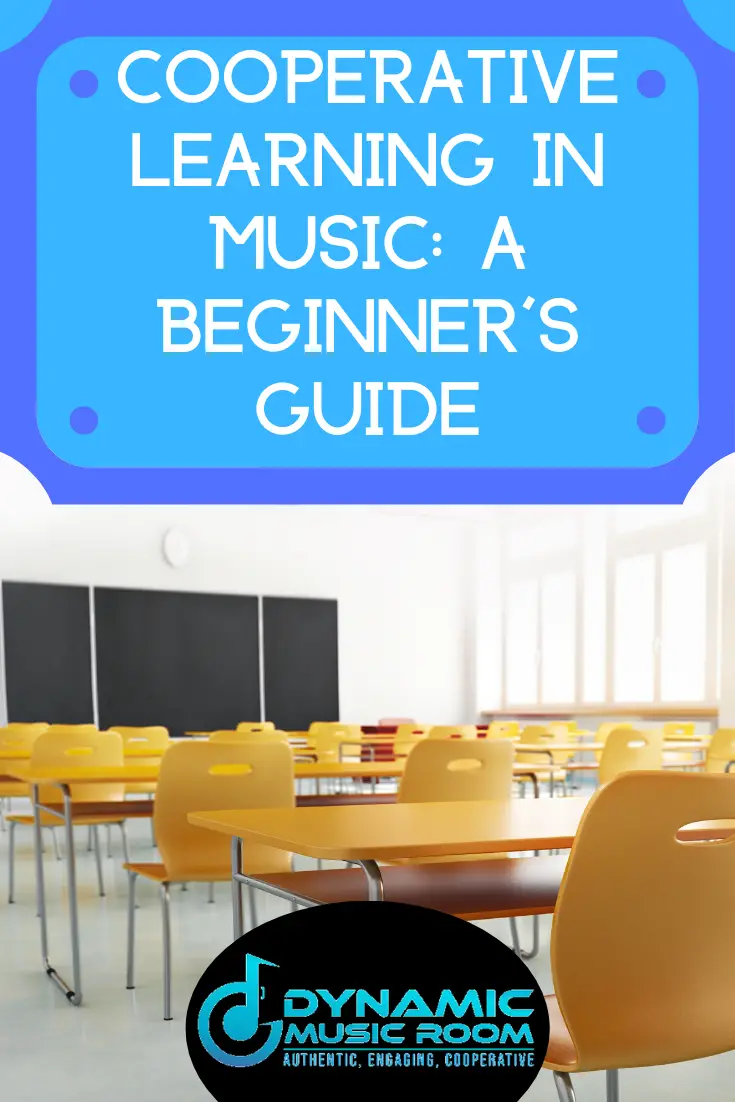
Group Compose
Grade: 5th grade
Musical Concept: Composing using known elements
Grouping: 4, teacher-selected
Goal: Create a 32 measure composition using known musical elements
Accountability:
- Group: Create and perform a 32 measure composition for the teacher or class.
- Individual: Each individual is responsible for their own 8 measure phrase.
Materials: Composition mats with dry-erase markers and erasers, alternatively: iPads or Chromebooks may be used, talking drum stick
Expectations:
- Students will be responsible for their own measures and also for working together to decide on the order of phrases
- Students will not make fun of others’ ideas
- The group will agree on meter and mode before working on their own
- Groups will raise their hand to ask a question and/or settle a dispute
- Only one person will speak at a time
- When the teacher attention signal is heard, all activity and talking will stop right where it is
Social Prompts:
When ideas are shared:
Your idea was fascinating! It takes a lot of courage to share a personal idea.
When a critique is offered:
I like your idea like it is, but what do you think about this?
When critique is heard:
Thanks for your input! It shows you care. I like it; let’s change it (OR) Your idea is good, but I like it the way it is.
Procedure Explanation:
1. Getting Set
Groups of 4 are given composition mats and writing materials (or other technology).
The groups must discuss and vote on meter and mode for their 32 measure composition. The instrument may also be picked, but I find it easier to tell them this will be sung or played on recorder, xylophone, or piano.
Each person gets one chance to say which meter or mode they wish for and only when holding the talking stick. Then, they vote.
Majority rules, and the others must follow. Disputes and ties are settled by best 2 out of 3 rock, paper, scissors or teacher intervention.
2. Individual Work
The groups work on their own 8 measure composition. At any time, they may ask one member of their group for help by tapping on their shoulder and whisper discussing.
Every 5 minutes, the teacher will call for a group check-in where the group shares what they have so far with each other (one at a time).
If the group notices one person falling behind, they offer help and suggestions. At no point are they allowed to write the answers for the students or tell them what to put down.
Repeat until each individual is done with their part and their name is on their work.
The teacher should be helping kids stay on task and work on their parts.
3. Put together a whole 32 measure song.
Students share their ideas and brainstorm different ways to order their individual parts.
Each suggests one order and the group votes until there is a majority.
4. Practice and perform
The group must practice and perform their song either by singing or playing.
When the teacher hears their performance (either in the small group or to the whole class), the students share which part was theirs.
Why Some Teachers Hate On Cooperative Learning
Cooperative learning is loved by most teachers who try it, but there are those who refuse to give it a shot or attempt it and write it off.
These are the common reasons why (with rebuttals).
The Classroom Is Too Chaotic!
At first, the classroom will seem more chaotic.
When you start, your students will have a hard time staying on task because they don’t know how to work together.
But if you stay consistent, teach them how to interact, and set up and follow through on expectations it gets quite smooth in a short period of time.
The problem comes when you forget to do these things or you aren’t consistent.
It Requires Too Much Work Ahead Of Time.
Yes, there is more “front-loading” or planning ahead with CL. This is especially true in the beginning when you’re not comfortable with the strategies.
However, I believe this “extra” work is offset by:
- With practice, it gets easy
- The heavy burden is off your shoulders when groups are working
No, you don’t want to chill while the students are working, but you don’t have to be performing. You focus on responding to the students’ work and helping them where they’re at.
The “Smart” Students Will Do All The Work.
In group work, yes, the “smart” ones usually end up doing the work.
But not with CL.
In CL, your structures are set up with accountability for all members, and you give each student a role to ensure equal participation.
Then, you follow this up by monitoring and redirecting when some group members try to take over.
The “Low” Students Will Be Confused And Embarrassed.
There will always be confusion and potential embarrassment in classrooms.
Confusion is OK as long as you make it OK.
Embarrassment, not so much.
However, the role system and structures make working together a bigger priority and helps build confidence.
You also monitor to help prevent and fix potentially embarrassing situations.
I’d also like to ask:
Aren’t your “low” students embarrassed to try in a normal setting?
It’s better to fail in a small group than in front of the whole class. With the proper social interactions modeled, this will help too.
I Question How Much My Students Are Actually Learning.
You may feel like unless you have an individual assignment turned in from each kid you can’t control their learning.
Here’s a secret:
You can’t really control their learning, anyway!
Learning is an individual thing, but by working in a small group effectively (as CL does), the individual gets the support they need while not feeling lost and actually contributing to the group.
It’s Impossible To Keep Track Of Every Student.
Isn’t it already hard anyway?
This actually makes it easier. With students engaged in groups, your monitoring gives you a better snapshot of how the student is performing in a more authentic situation.
It Doesn’t Work For My Subject Area.
Maybe you’re having a hard time imagining it, but CL works for any content area at any age.
Collegiate and adult groups use this to work better together in pretty much every area imaginable.
Don’t give up because it doesn’t immediately apply to your situation. Reach out to others and get creative.
The benefits are too good to just leave this out.
Cooperative Learning Resources To Look Into
Once you’ve used this a few times, it becomes much easier to create new lessons using CL. But you don’t have to reinvent the wheel, just look at some of these resources for a shortcut.
Kagan Cooperative Learning – This is the bible for most CL texts. No, this isn’t music-specific, but it covers all the basics you need to get started.
Cooperative Learning And Music – This is the Kagan-approved text for building a Kagan music classroom based on using CL.
The lessons and activities in here are good, though they may not match up with your exact content and teaching style.
However, the thorough examples are great launching points for adapting to your own needs.
Making Music Cooperatively – This book is great for music teachers with a little background in CL and need more examples and to hear someone’s actual experience using it in the music classroom.
For those in the beginning of CL, you may wish to buy this as a companion to one of the others or along with a training.
Conclusion
I hope you find this cooperative learning in music beginner’s guide helpful to you.
The benefits are clear and apply to music at any level.
Avoid missing one of the 5 parts of CL and stick with it.
Anything new is always messy at first, but with practice and good resources, you’ll help your students gain confidence, improve their musical skills, and learn to work better together.

